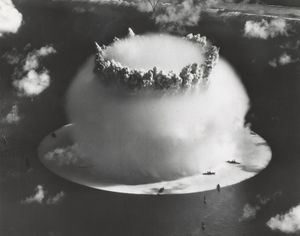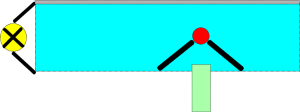غرفة السحابة
 The original cloud chamber of C. T. R. Wilson at the Cavendish Lab, Cambridge, England. | |
| الاستخدامات | Visualizing ionizing radiation |
|---|---|
| التجارب البارزة | Discovery of the positron |
| المخترع | Charles T. R. Wilson |
| أشياء متعلقة | Bubble chamber Wire chamber |
| المادة المضادة |
|---|
 |
غرفة السحابة Cloud chamber أو غرفة وِلسون المعتِمَة جهاز يجعل ممرات الجسيمات الذرية المشحونة كهربائيًا مرئية. يفحص العلماء هذه الممرات لإيجاد شحنة الجسيم وكتلتها وسرعتها. وتشمل الجسيمات التي يمكن ملاحظة ممراتها في غرفة ولسون المعتمة أشعة ألفا وأشعة بيتا، من المواد المشعة، والأشعة الكونية الواردة من الفضاء الخارجي. اخترع غرفة ولسون المعتمة الفيزيائي البريطاني تشارلز ولسون في عام 1912م.
الاختراع
تعد أولى الحجرات، وقد استعملها تاونسند J.S.Townsend عام 1897 وتومسون J.J.Thomson عام 1898 لتحديد شحنة الإلكترون، وذلك قبل استعمال الأخير أنبوب الأشعة المهبطية.
تتلخص الطريقة بتحضير بخار الماء الموجود في حجرة ضمن شروط قريبة من شروط التكثف، وما إن تتواجد الأيونات حتى يتكاثف البخار عليها مكونة سحابة على طول المسار. تقاس بعد ذلك الشحنة الكهربائية التي تحملها السحابة وتقسم على عدد القطيرات لتستنتج واحدة الشحنة الكهربائية. طوّر س.ت.ويلسن C.T.R.Wilson ومن بعده هـ.أ.ويلسن H.A.Wilson، هذه الفكرة فصنعا حجرة أسطوانية ذات مكبس قابل للحركة يستعمل لتهيئة الشروط المناسبة للتكاثف، مغلقة بنافذة شفافة تجعل التصوير ممكناً في اللحظة المناسبة. كما أدخلا إمكانية تطبيق حقول مغنطيسية وكهربائية تساعد على تحديد خواص الجسيمات بتتبع المسارات وانحناءاتها الناتجة من تطبيق الحقول،مثل كتلة الجسيم وطاقته إضافة إلى شحنته. وقد استعمل فيما بعد خليط من الغازات والأبخرة، فلم تعد مقتصرة على بخار الماء بهدف تحسين مقدرة فصلها وتوسيع مجالاتها الطاقية، وتعرف أيضاً باسم حجرة ويلسن.
طورت بعد ذلك حجرة الفقاعات bubble chamber التي يستعاض فيها عن البخار فوق المشبع بسائل فائق التسخين superheated، فإذا ما خفض الضغط المطبّق على السائل فجأة تشكلت فقاعات تنمو على الأيونات أو الإلكترونات الموجودة. وغالباً ما يستخدم الهدروجين السائل الذي يعد التفاعل مع نوياته تفاعلاً مع بروتونات. استطاعت مثل هذه الحجرات الكشف عن مكونات الأشعة الكونية التي تحتوي على جسيمات ذات طاقة عالية وعن تفاعلاتها النووية ونواتجها من الجسيمات قصيرة العمر، دعمت بذلك ووجهت النظريات المتعلقة بالإشعاع النووي الناشط بعد أن كان يعتمد على صفائح التصوير للكشف عنها اعتماداً كلياً.
تقدم تصميم الحجرة خطوة أخرى، من حجرة مكونة من سطحين دائريين مستويين متوازيين إلى سطح أسطواني وسلك رفيع عند محور الأسطوانة معزول عنها، يربط كل منهما بأحد قطبي مدخرة فيجمع أحدهما الشحنات الموجبة بينما يجمع الآخر الشحنات السالبة، ويقومان، إضافة إلى ذلك، بتسريعها، مما يؤدي إلى قيامها بتأيينات إضافية في الوسط، فتتشكل نبضة كهربائية عند مخرج الدارة الكهربائية؛ يمكن باختيار مناسب للكمون المطبق ولمزيج من الغازات، مثل الأرگون والآزوت والكحول، أن يقابل كل نبضة جسيم وارد، ومن ثم يكون عدد النبضات متناسباً مع عدد الجسيمات، فيسمى عداد غايغر - موللر التناسبي. وقد يطلى السطح الداخلي للأسطوانة بمادة تتفاعل مع النترونات تفاعلاً نووياً مثل البورون فتستعمل عندها عدادات للجسيمات المعتدلة كهربائياً.
سحابة ولسون

تتكون الغرفة المعتمة البسيطة من وعاء مجهز بمكبس، يحوي هواء، أو غازًا آخر، شديد التركيز، مع بخار الماء، أو بخار الكحول، أو كليهما. وعندما تمر الجسيمات المشحونة كهربائيًا عبر الغاز ترتطم بالإلكترونات، فاصلة إياها عن الجزيئات الواقعة في طريقها، ومغيرة تلك الجزيئات إلى أيونات. ويتجمع البخار حول الأيونات بحيث يكون قطيرات تشكل علامات شريطية مرئية داخل الغرفة المعتمة. وبذلك تمثل هذه العلامات الشريطية ـ التي تُسَمَّى المَجَازَات أيضًا ـ ممرات الجسيمات المشحونة. وتختفي المجازات بسرعة، إلا أن العلماء يمكنهم تصويرها عبر جدار زجاجي أو نافذة زجاجية، معدة لهذا الغرض.
ولكي تتمكن المجازات من التكوُّن، لابد أن يصير الغاز داخل الغرفة المعتمة فائق التشبع أي أن تكون رطوبته النسبية أكثر من 100%. يصير الغاز المشبع فائق التشبع عندما يبرد. ويبرد الغاز المشبع داخل الغرفة المعتمة بتحريك المكبس إلى الخارج، وبسبب انخفاض الضغط داخل الغرفة الناتج عن حركة المكبس؛ ومن ثم يتكثف البخار في الغاز على الأيونات ليشكل قُطَيْرات. وفي كثير من الغرف المعتمة تُقدح حركة المكبس بإشارة من عدادات إلكترونية يمكنها رصد الجسيمات المشحونة كهربائيًا.
ويشيِّد العلماء الغرف المعتمة غالبًا بين قطبي مغنطيس كهربائي، حيث يجعل المغنطيس الجسيمات المشحونة داخل الغرفة تتحرك على امتداد ممرات مقوسة. ومن هذه الأقواس يستطيع العلماء إيجاد القوة الدافعة للجسيم.
التركيب والتشغيل


Diffusion-type cloud chambers will be discussed here. A simple cloud chamber consists of the sealed environment, a warm top plate and a cold bottom plate (See Fig. 3). It requires a source of liquid alcohol at the warm side of the chamber where the liquid evaporates, forming a vapor that cools as it falls through the gas and condenses on the cold bottom plate. Some sort of ionizing radiation is needed.
Isopropanol, methanol, or other alcohol vapor saturates the chamber. The alcohol falls as it cools down and the cold condenser provides a steep temperature gradient. The result is a supersaturated environment. As energetic charged particles pass through the gas they leave ionization trails. The alcohol vapor condenses around gaseous ion trails left behind by the ionizing particles. This occurs because alcohol and water molecules are polar, resulting in a net attractive force toward a nearby free charge (See Fig. 4). The result is a misty cloud-like formation, seen by the presence of droplets falling down to the condenser. When the tracks are emitted from a source, their point of origin can easily be determined.[1] Fig. 5 shows an example of an alpha particle from a Pb-210 pin-type source undergoing Rutherford scattering.
Just above the cold condenser plate there is a volume of the chamber which is sensitive to ionization tracks. The ion trail left by the radioactive particles provides an optimal trigger for condensation and cloud formation. This sensitive volume is increased in height by employing a steep temperature gradient, and stable conditions.[1] A strong electric field is often used to draw cloud tracks down to the sensitive region of the chamber and increase the sensitivity of the chamber. The electric field can also serve to prevent large amounts of background "rain" from obscuring the sensitive region of the chamber, caused by condensation forming above the sensitive volume of the chamber, thereby obscuring tracks by constant precipitation. A black background makes it easier to observe cloud tracks, and typically a tangential light source is needed to illuminate the white droplets against the black background. Often the tracks are not apparent until a shallow pool of alcohol is formed at the condenser plate.
If a magnetic field is applied across the cloud chamber, positively and negatively charged particles will curve in opposite directions, according to the Lorentz force law; strong-enough fields are difficult to achieve, however, with small hobbyist setups. This method was also used to prove the existence of the positron in 1932, in accordance with Paul Dirac's theoretical proof, published in 1928.[2]
الكشف عن جسيمات أخرى
The bubble chamber was invented by Donald A. Glaser of the United States in 1952, and for this, he was awarded the Nobel Prize in Physics in 1960. The bubble chamber similarly reveals the tracks of subatomic particles, but inverts the principle of the cloud chamber to detect them as trails of bubbles in a superheated liquid, usually liquid hydrogen, rather than as trails of drops in a supercritical vapor. Bubble chambers can be made physically larger than cloud chambers, and since they are filled with much-denser liquid material, they can reveal the tracks of much more energetic particles. These factors rapidly made the bubble chamber the predominant particle detector for a number of decades, so that cloud chambers were effectively superseded in fundamental research by the start of the 1960s.[3]
A spark chamber is an electrical device that uses a grid of uninsulated electric wires in a gas-filled chamber, with high voltages applied between the wires. Energetic charged particles cause ionization of the gas along the path of the particle in the same way as in the Wilson cloud chamber, but in this case the ambient electric fields are high enough to precipitate full-scale gas breakdown in the form of sparks at the position of the initial ionization. The presence and location of these sparks is then registered electrically, and the information is stored for later analysis, such as by a digital computer.
Similar condensation effects can be observed as Wilson clouds, also called condensation clouds, at large explosions in humid air and other Prandtl–Glauert singularity effects.
الإستعمالات
تستعمل للكشف أحياناً حجرات مملوءة بمحلول مادة تتألق إذا أثيرت نتيجة امتصاص الإشعاعات، وقد تستعمل مواد صلبة تحتوي ذرات تتألق أوتومض نتيجة التصادمات. تسمى مثل هذه الكواشف أو العدادات عدادات وميضية أو تألقية scintillation counters، يقوم بتضخيمها ضوئياً وتعدادها أجهزة مناسبة.
ظهر أخيراً أنواع من العدادات أو الكواشف المصنعة من أنصاف النواقل المطعّمة بشوائب مناسبة لتشكل ثنائياً بلورياً diode يوصل بمدخرة وبمتممات إلكترونية للكشف عن الجسيمات والإشعاعات وتعدادها .تنتقى الحجرات والعدادات لتناسب أشعة معينة مثل أشعة گاما أو أشعة ألفا ولمجال طاقات مناسب، إذ إن لكل منها كفاءة تختلف باختلاف النوع وباختلاف مجال الطاقة. وأصبح ممكناً باقتران الكواشف والمعالجات الإلكترونية تحديد أطياف الإشعاعات المختلفة الصادرة عن المنابع وعن التفاعلات النووية بدقة عالية.
تنصبّ الاستعمالات الأولى للحجرات والعدادات في المؤسسات التي تتعامل مع المواد النووية مثل المسرّعات والمفاعلات والمستشفيات. لكن انتشار أجهزة الأشعة السينية وحدوث بعض الحوادث النووية التي تسببت بفاعلية إشعاعية في مناطق شاسعة،دخلت في الأغذية ومواد كثيرة جعل استعمال الحجرات والعدادات والكواشف النووية شائعاً جداً وفي مقدمتها أفلام التصوير وعدادات گايگر - موللر.[4]
معرض
A home-made cloud chamber.thin: β-particles). See also animated version
Cloud chamber during the European Researchers' Night at FZU.
Cloud chamber with visible tracks from ionizing radiation (short, thick: α-particles; long,
انظر أيضاً
- غرفة الإشعال الشراري
- Nuclear emulsion – also used to record and investigate fast charged particles
- Bubble chamber
- Spark chamber
- Gilbert U-238 Atomic Energy Laboratory science kit for children (1950–1951)
- Contrail
- Nephelescope
الهوامش
- ^ أ ب Zani, G. Dept. of Physics, Brown University, RI USA. "Wilson Cloud Chamber" Archived 2017-08-01 at the Wayback Machine. Updated 05/13/2016.
- ^ Anderson, Carl D. (1933-03-15). "The Positive Electron". Physical Review. 43 (6): 491–494. Bibcode:1933PhRv...43..491A. doi:10.1103/PhysRev.43.491.
- ^ "The Nobel Prize in Physics 1960". www.nobelprize.org. Retrieved 2015-04-07.
- ^ فوزي عوض. "الحجرات والعدادات النووية". الموسوعة العربية.
المصادر
Das Gupta, N. N. (1946). "A Report on the Wilson Cloud Chamber and its Applications in Physics". Reviews of Modern Physics. 18: 225–365. doi:10.1103/RevModPhys.18.225. {{cite journal}}: Unknown parameter |coauthors= ignored (|author= suggested) (help)
وصلات خارجية
| Cloud chambers
]].









